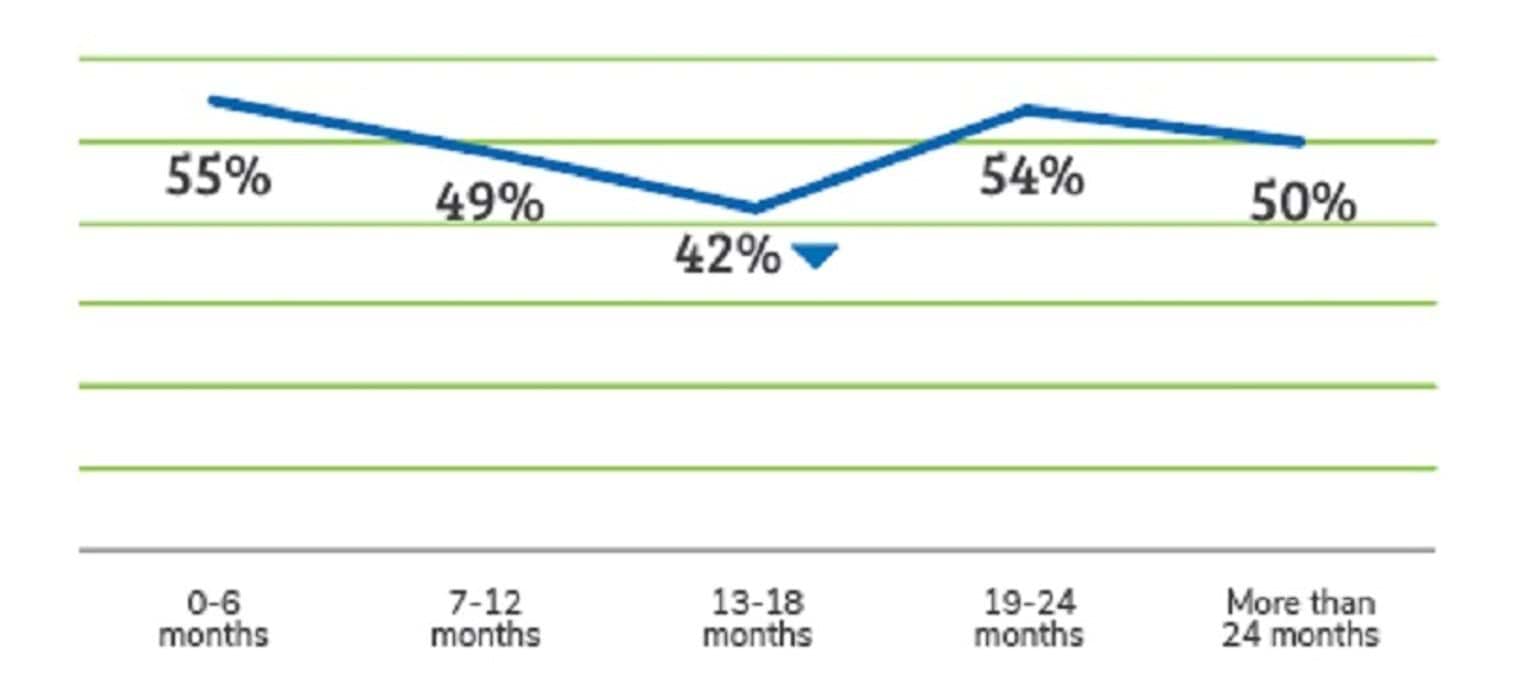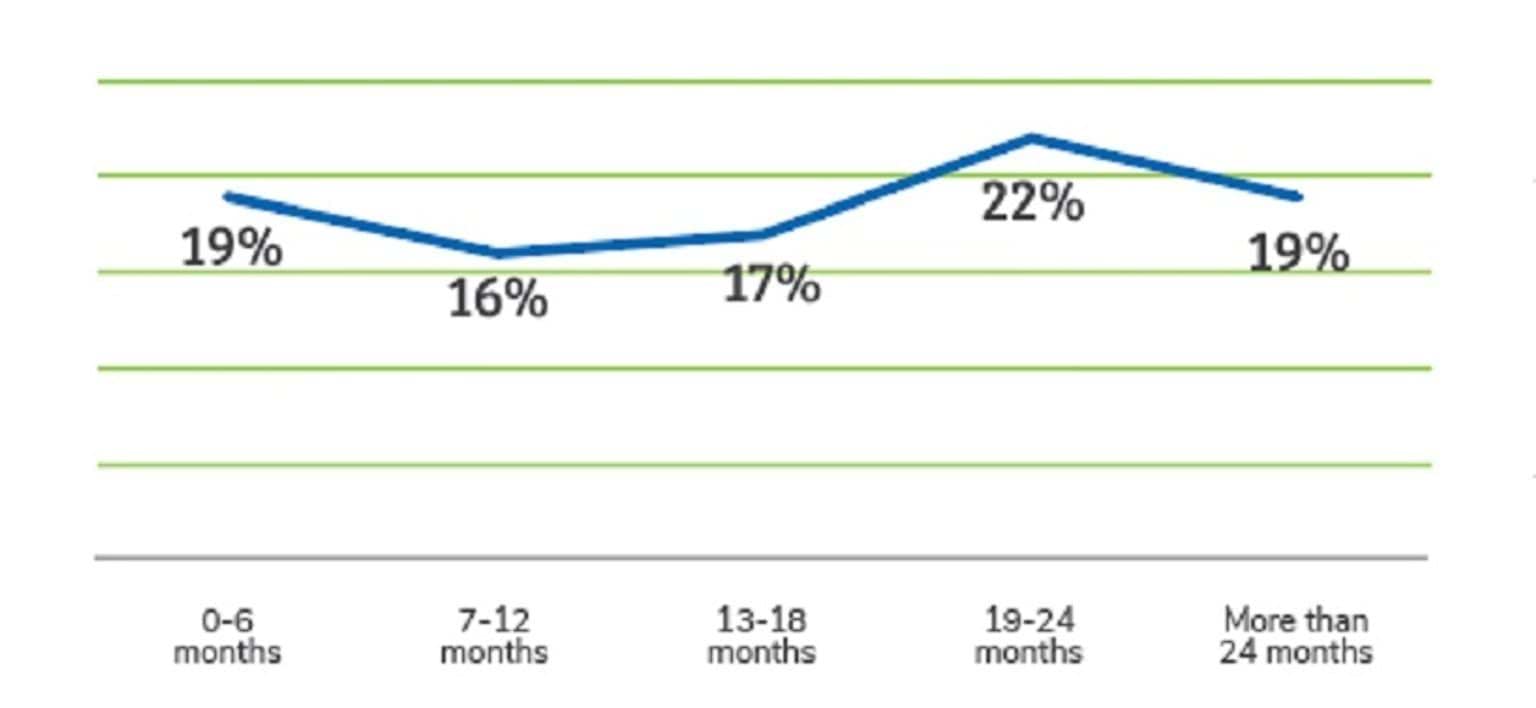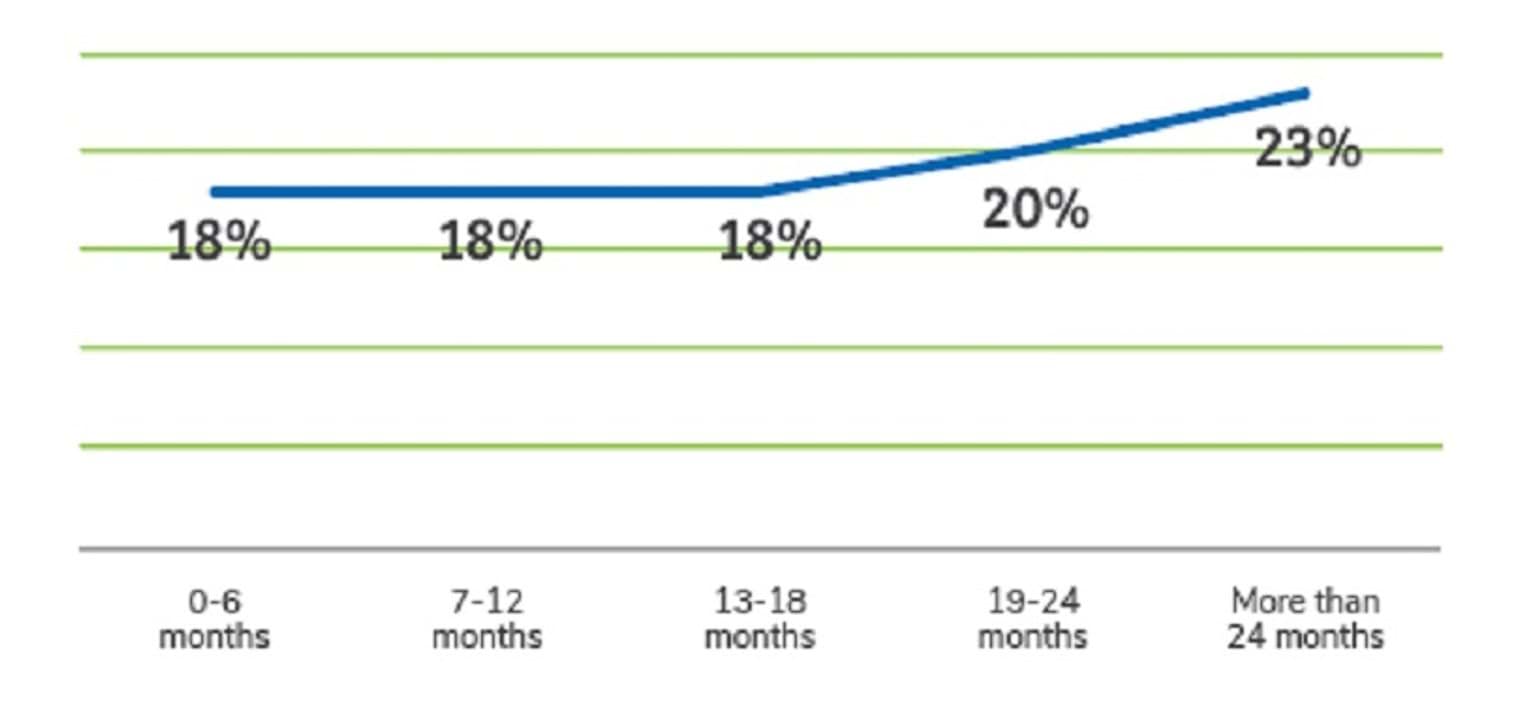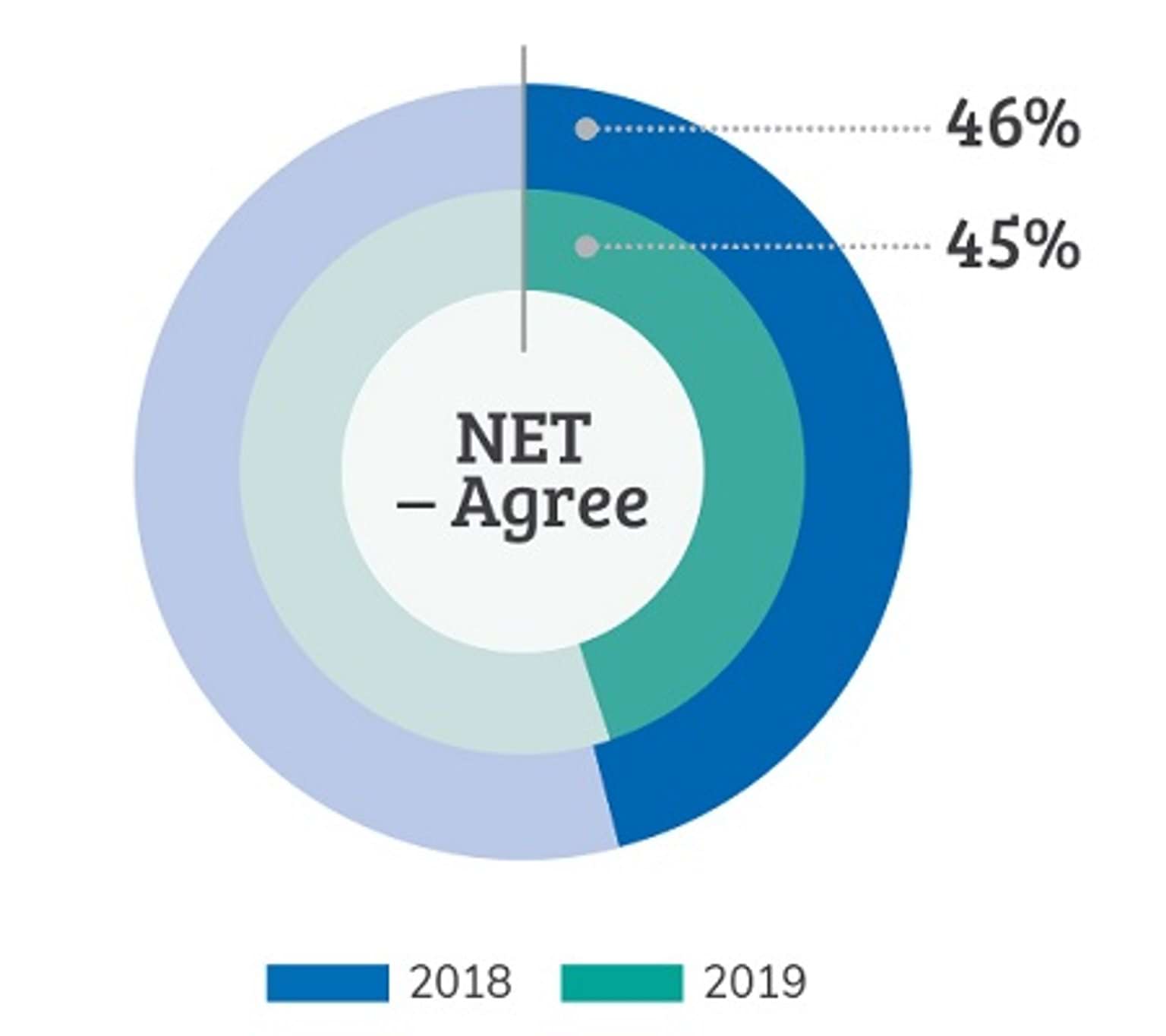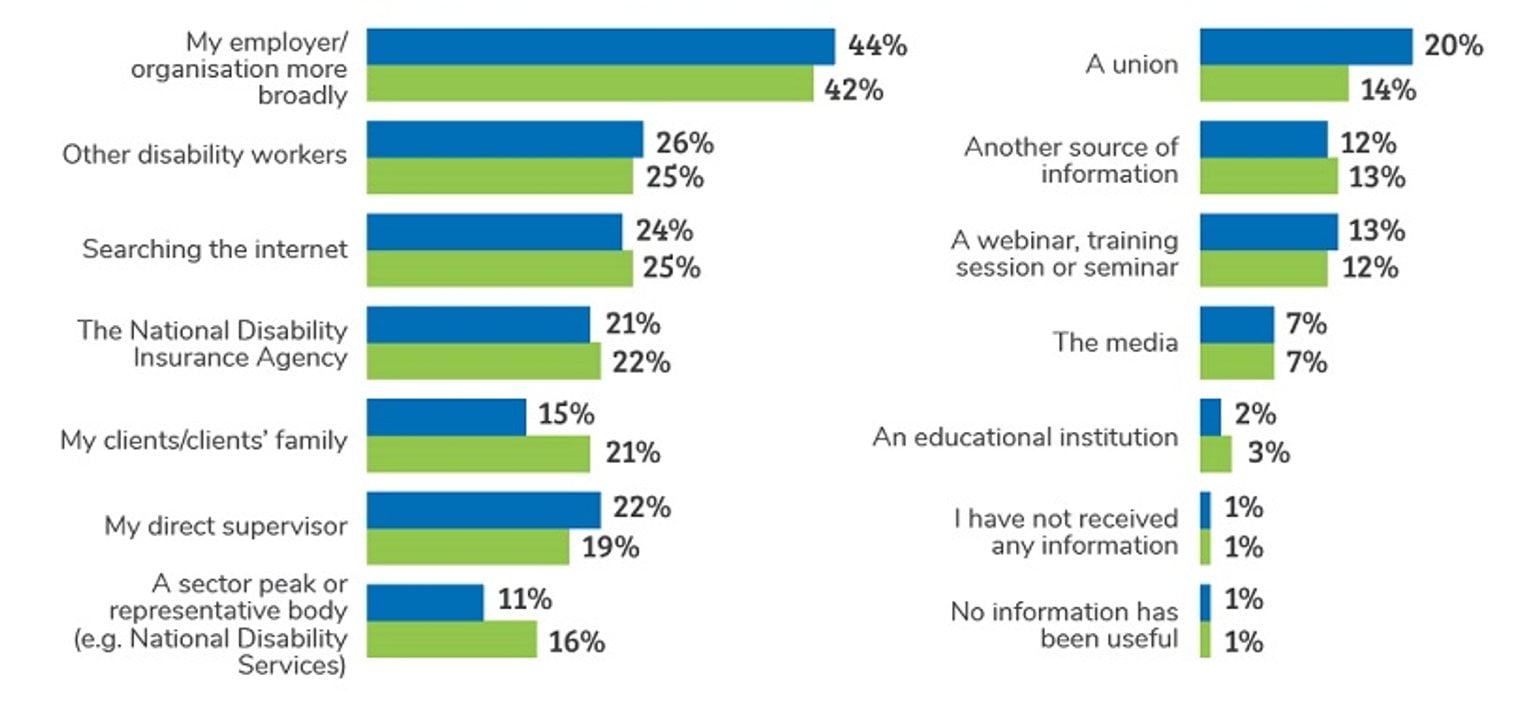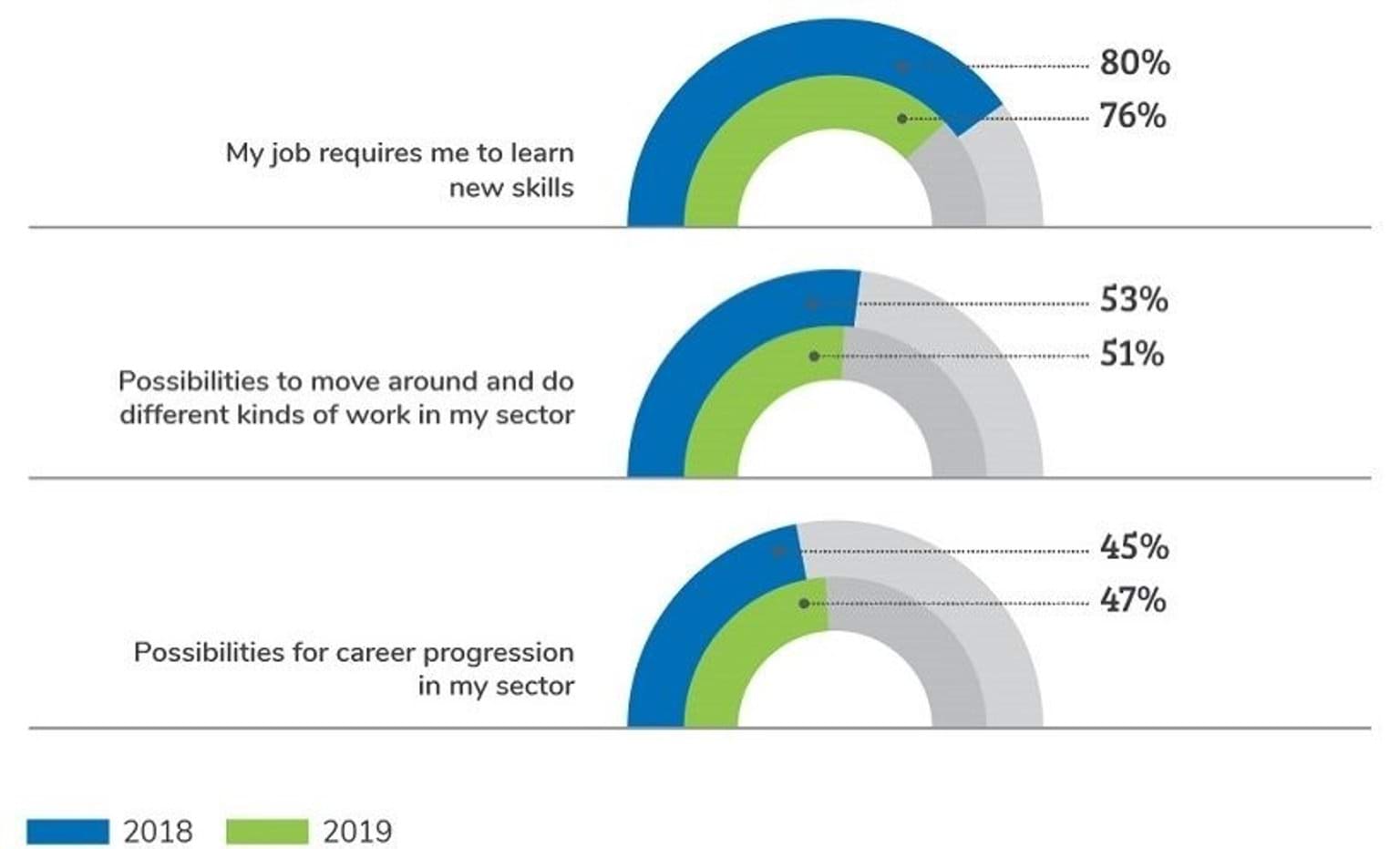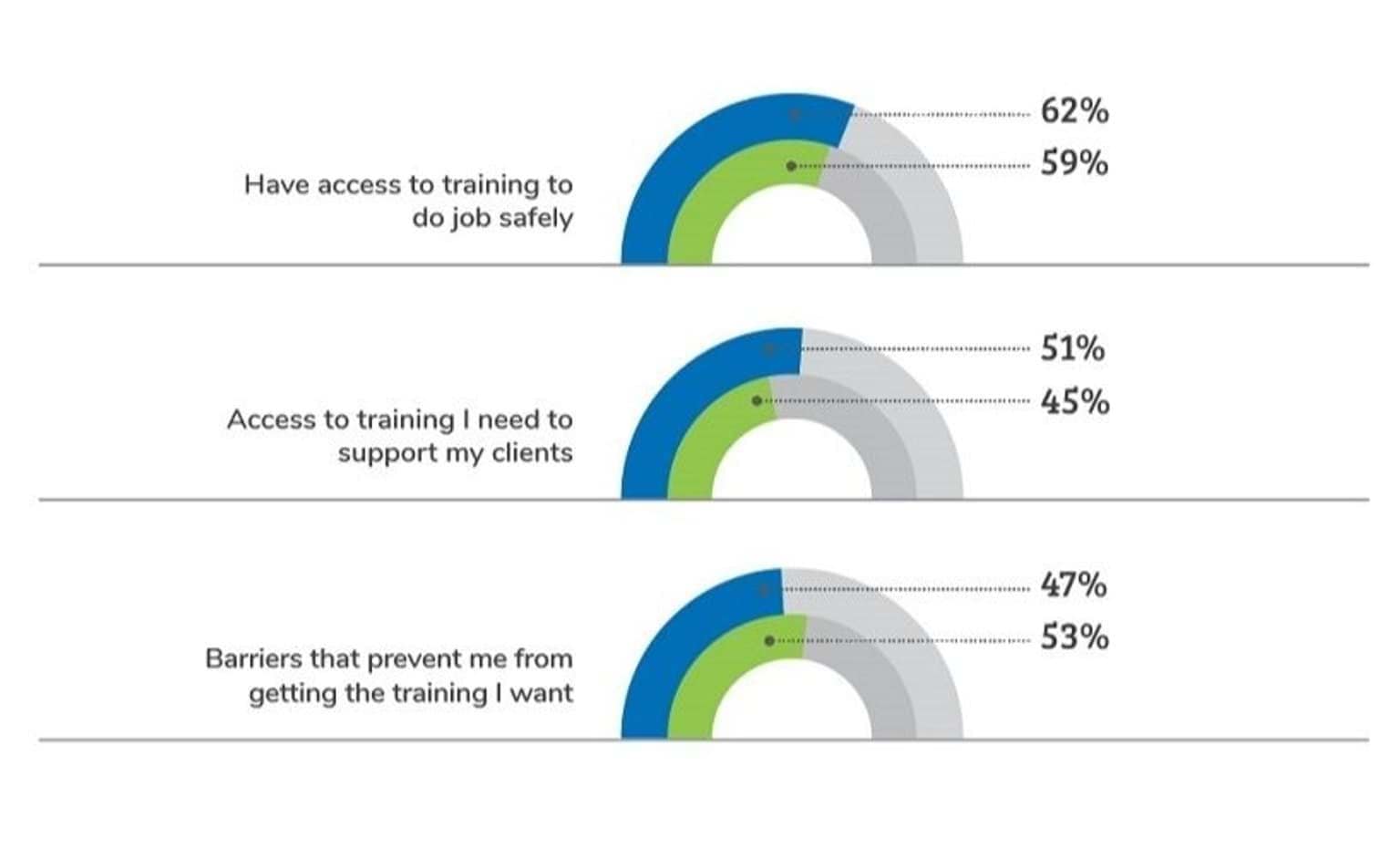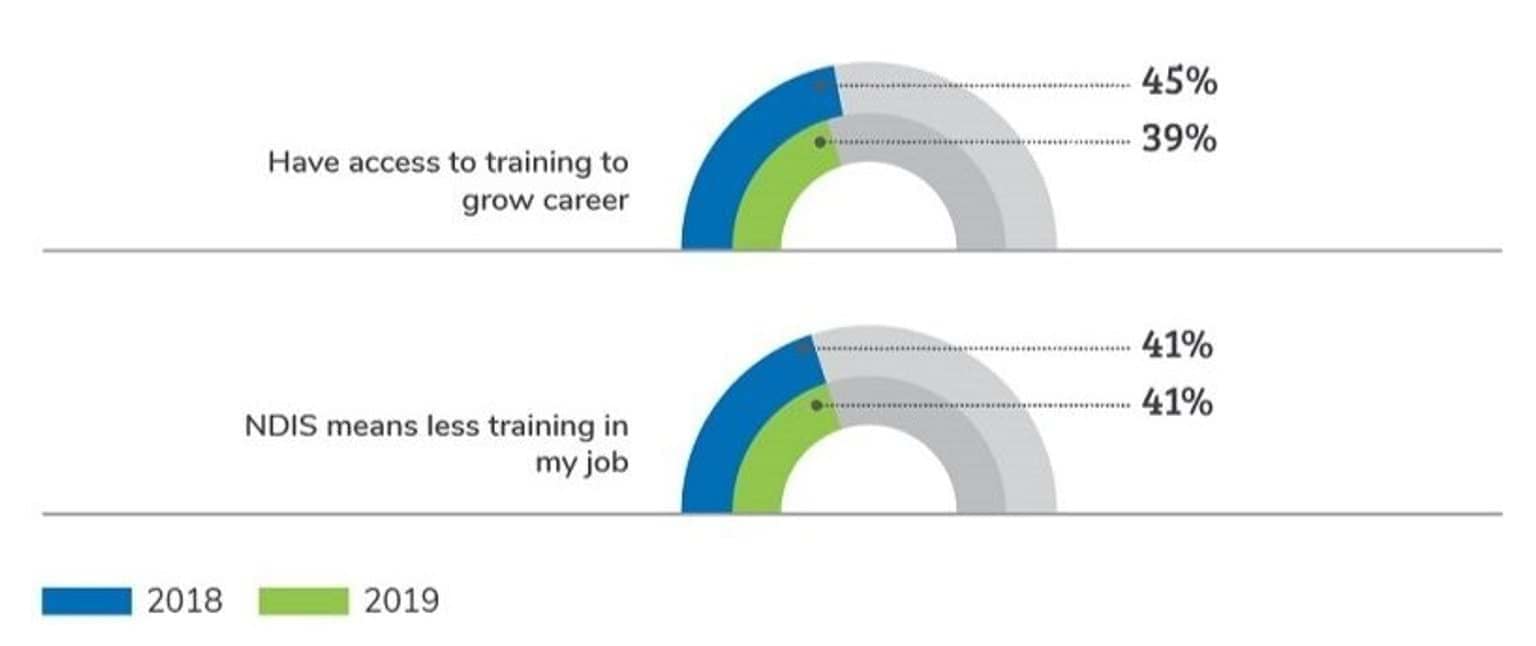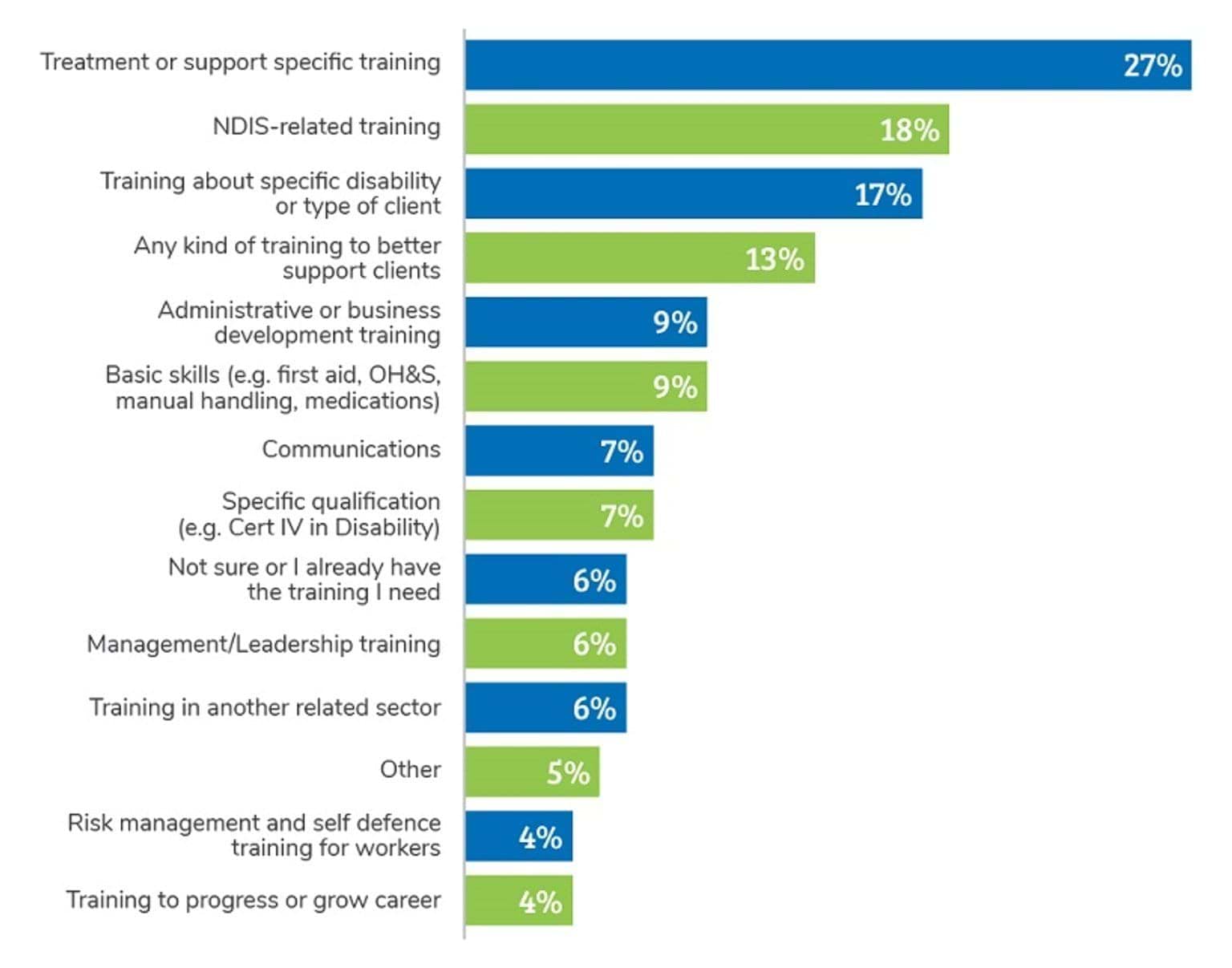- Date:
- 31 Dec 2019
Research project delivered by the Department of Health and Human Services (Victoria) and conducted by Ipsos Public Affairs.
Introduction
Understanding the workforce experience of the NDIS: longitudinal research project is a 3-year study that aims to build an understanding of the disability workforce’s experience of the National Disability Insurance Scheme (NDIS).
Specifically, the research aims to understand the workforce’s perceptions of the NDIS and experience of transition, how the NDIS is impacting their work, and the skills and training the workforce needs under the NDIS.
This research will help the Victorian government better support the workforce during this time of unprecedented change. This research project forms a key component of Keeping our sector strong - Victoria’s Workforce Plan for the NDIS (the Plan) and more specifically its objective to build intelligence on the disability workforce.
The 2019 research was the second iteration of the study and it expanded on the intelligence gathered in 2018. This report presents key findings and recommendations from the second of three years of longitudinal research. The results highlight both the challenges faced by the workforce in transitioning to the new scheme, and a range of opportunities to support the workforce.
The research was commissioned by the Victorian Department of Premier and Cabinet1 and conducted by Ipsos Public Affairs, an independent research consultancy. Research has been guided by an Expert Advisory Panel (EAP), including representation from:
- The Health and Community Services Union (HACSU)
- VCOSS-RMIT Future Social Service Institute
- National Disability Services
- Carer Solutions Australia
- 2 research participants
- The Department of Health and Human Services
Footnote
1 The workforce design team is now positioned within the Disability and Communities Branch of the Department of Health and Human Services (DHHS). For the remainder of the report DHHS will be referenced where relevant.
Why did we conduct the research?
Outlines why we need to understand the experiences of disability workers over time.
In March 2013, legislation was passed in Australia to establish the NDIS, which aims to provide Australians with a permanent disability the “reasonable and necessary supports they need to live an ordinary life”.
The scheme involves a new way of funding disability services: rather than funding being directed to disability support providers, it is provided directly to people with a disability (NDIS participants). Participants select who will provide their supports and services and can negotiate how these are delivered. This gives people with a disability more choice and control managing their disability supports.
In Victoria, the NDIS rolled out to different regions in stages, beginning in 2013 and ending in 2019. The NDIS has meant a big change for participants, but also for people working in the disability sector. In some areas in Victoria there is a need to almost double the disability workforce to meet the needs of participants. The NDIS also demands new skills and new ways of working and it may affect the structure of the workforce and employment arrangements.
While some research has already been done about the workforce’s experiences of the NDIS in pockets of the sector, there was a need for research across Victoria on how the workforce in all disability settings and regions are experiencing the rollout over time. Improving the understanding of these issues will mean that the Victorian Government, the National Disability Insurance Agency and disability service providers are able to support the existing workforce during this time of unprecedented change. It will also help the Victorian Government build a workforce that is skilled, diverse and delivers high-quality, innovative support to achieve the best possible outcomes for people with disability.
How did we conduct the research?
Explains what method and types of questions we used to gather information for the NDIS workforce longitudinal research study in 2019.
The methodology and questions used in this research were designed in collaboration with experts from the sector: disability workers, service providers, the Health and Community Services Union, peak bodies and government. Together, it was agreed that a survey was needed to measure the impact of the NDIS on the workforce over time, followed by qualitative research to understand the experiences of workers in greater depth.
Workers were invited to participate in the research through disability networks, by direct contact with disability providers, and through an advertisement on the Victorian Government website. Workers registered for the survey and then completed it online via an email invitation.
The survey involved a range of closed and open-ended questions and gave workers the option to register their interest to participate in future qualitative research. The focus groups and in-depth interviews were more open-ended in nature, allowing workers to describe their experience in their own words.
Throughout this report, findings from the survey are presented as statistics, and findings from focus groups and in-depth interviews are presented as summaries of workers’ words, and in direct quotes from workers.
In 2019, 722 workers participated in the survey, 328 of whom had participated in 2018 and therefore were treated as longitudinal participants. The remaining 394 survey respondents had only participated in 2019 and were deemed new participants. Results were consistent across these cohorts and there were limited differences in feedback.
In total, 87 workers also participated in the qualitative research in either one of six focus group (32) or an individual in-depth interview (55) held across the state between May and July 2019.
Who took part in the research?
Information about the disability workers who took part in the NDIS workforce longitudinal research study in 2019.
An effort was made to recruit people from all disability settings and across Victoria.
As in 2018, survey participants were most commonly aged 45-54, located in metropolitan Victoria and had worked in the sector for over 20 years. They were most commonly employed full time, worked in the public sector and were working in established regions in terms of NDIS rollout stage. Over half worked in a residential setting, and almost seven-in-ten were members of HACSU.
Key characteristics of survey participants in 2019 are outlined below.
What did we find?
Detailed findings from the NDIS workforce longitudinal research study in 2019.
Overall
The research identified very little change to the experiences of the disability workforce between 2018 and 2019, and all the key findings identified in 2018 continue to be relevant. Workers continue to be passionate about their clients and their work, there is general support for the NDIS’s mission and an understanding that the NDIS has the potential to increase innovation and create new opportunities for workers. However, workers are continuing to experience anxiety and uncertainty about the NDIS. Many workers see the NDIS as reducing time and funding for the things that matter and are concerned about the impact of the NDIS on security, quality and safety for them and their clients.
Feelings of isolation among the workforce emerged as a key theme in 2019, with the move to billable hours seen as reducing time for collaboration and learning.
"A lack of ability to mentor and collaborate... makes you feel much more isolated and doesn’t allow you to develop the professional skills. [It is] harder in the country, you can’t get together in a meeting and share ideas, the collaboration and camaraderie has gone."
The research identified a lack of knowledge about career pathways and an appetite for further information and clarity about the scheme, including direct communication about the NDIS, ideally delivered face-to-face by credible colleagues in their practice area.
Notably, it was found that the NDIS is experienced differently by different types of workers across the sector, and those at differing stages in the rollout.
Key findings regarding how people are feeling about their work as the NDIS rolls out are detailed overleaf. These findings are followed by two spotlight sections on communication and career progression, which were topics explored in-depth in 2019.
How are people feeling about their work as the NDIS rolls out?
In the qualitative research, study participants talked about how they felt about their work at the moment. Some felt hopeful or happy about their work, while others felt overwhelmed, disempowered or confused.
Some opportunity and positivity
Some workers relished the new opportunities presented by the NDIS to support participants in innovative ways or specialise in different areas and enjoyed their exposure to a broader range of clients.
"Yes, there is definitely personal satisfaction in seeing it (the NDIS) work for some families, we’re working out how to regain some of the evidence based best practice and knowing that we’re making a real impact. I’m always up for a challenge."
Workers are still feeling uncertain about the impact of the NDIS
Despite the NDIS being rolled out in all regions in 2019, many workers were still uncertain about how it would affect their jobs and what their responsibilities would be under the new scheme. For many it was still too soon to comment on the broader impact of the NDIS on the workforce. The following analogy was used:
"The NDIS is like flying in an aeroplane while it is still being built around us."
Devalued and disempowered
A recurring theme for 2019 was that many workers feel devalued and excluded from information about the NDIS and the planning process for their clients. This was often attributed to losing their roles as advocates for clients or participants in care planning, with many lacking access to their participants’ NDIS plans or goals, which they report is essential to delivering person-centred services under the NDIS.
This was particularly the case for direct support workers, with those in more specialised fields such as Allied Health often feeling more supported and able to negotiate with participants to ensure goals were shared.
Some workers felt that they are losing quality time with their clients because of billable hours, or because the work they find most enjoyable, such as community access work, is being delivered by different services or workers.
"Now with the rollout of the NDIS there are NDIS coordinators who work with the families to make sure that they get the right funding, but the National Disability Insurance Agency (NDIA) assigns coordinators and it can be difficult to get one who knows what’s right for the clients. They don’t give the staff a chance to be able to prove to them that we know what the resident needs, they paralyse you, don’t give you the time or the chance to prove your skills."
Concerned about clients
For some of those who had rolled into the NDIS by the second wave of research many of their fears were confirmed, such as having less time to support their clients, experiencing changes in work hours and witnessing clients missing out.
The sector’s difficulties in retaining experienced workers under the NDIS, coupled with growing demand, meant that many workers had witnessed their employer increasingly hiring less experienced staff to meet demand. There was considerable concern about the impact of this on client wellbeing and worker morale.
"There are not enough disability workers to work with clients so they seem to be taking less experienced workers, which is not good for the workers and for the clients."
"There are lots of people coming into the NDIS as a career change but they’re not coming with any qualifications. Experience makes a difference. When I work with people with a diploma or degree I see that in their practice. It reflects the rigour of their qualifications [and] makes a difference to the work they do."
Does length of time since rollout have an impact on how the workforce feels?
The NDIS rolled out in different regions of Victoria between 2013 and 2019. This means it is possible to use our research to understand how the workforce’s experience differs by how long they have spent under the NDIS.
Overall, the study found workforce sentiment decreases with increased exposure to the NDIS, hitting its lowest point at 13-18 months following rollout. Positively, sentiment increases significantly following this milestone, but then declines for those who have been working under the NDIS for 24 months or more.
Advice from sector experts suggests this may be due to the two-year plan review taking place at this point for participants, or because those who worked in early rollout regions have experienced more teething issues with the scheme.
See below for key findings on length of time since rollout versus workforce sentiment.
Key tension point: 13-18 months from rollout
When looking at current work sentiment over time, a decrease in sentiment can be seen for those 13-18 months into their rollout. It is possible that the decrease in sentiment may relate to this group encountering more early issues with the scheme rather than the length of time since rollout.
Positivity about the future of work improves as the NDIS is rolled out for longer
Across the workforce, optimism about the future was low. However, positivity does seem to increase gradually with exposure to the NDIS.
Agreement that the NDIS is positive change for me in my work most likely at 19-24 months post rollout
There was also limited agreement that the NDIS is a positive change for workers. This follows a similar pattern to overall workforce sentiment, increasing by the 19-24 month mark, and then decreasing for those who had been working under the NDIS for more than 24 months.
This analysis indicates an opportunity to work differently across the workforce to retain clarity for workers in the recent to moderate stage of rollout by providing a clear vision and information. This may lessen the heightened anxiety experienced at 13 to 18 months post rollout. Overall, there is an appetite for clarity and transparency around NDIS processes and opportunities with use of simpler instructional language.
The analysis also indicates that a different approach should be utilised for those 19 to 24 months out from rollout who are increasing in positivity and perhaps getting accustomed to the new system. This stage could be the key time to start introducing new training and retention interventions when both workers and employers are feeling more stable.
The analysis also shows that while subtle, there seems to be a trend towards improvement in the perception that the NDIS is a positive change for the workforce as the NDIS rolls-out. However, further support may be required to maintain this improvement following the 24-month mark.
Spotlight - communication needs
Through focus groups and in-depth interviews disability workers told us about their communications needs.
This year, focus groups and in-depth interviews explored the communications needs of the workforce and found that generally, workers would like to receive more information about the NDIS to enable more certainty about their roles and empower them to better support their clients. There were particularly strong needs in relation to the content and status of clients’ plans, a need for tailored information, and a need to ensure that information provided to employers is adequately disseminated to all staff.
Communication about clients was top of mind
When asked about communications, workers who participated in the qualitative research tended to focus on a desire to know more about the planning process for their clients. Many workers reported not knowing the status of participant’s plans, details of their goals, or not receiving the details of a client’s history to inform their support approach. For many, addressing these gaps in information was the key priority.
"I need to know more [about my clients]: what are their goals? What I am supporting them for? I’m not just walking in to do domestic jobs. [I want to] be part of the team."
Workers want more direct communication about the NDIS, generally delivered face-to-face by credible colleagues in their practice area
When asked about communication about the NDIS more broadly, many workers cited a preference for face-to-face delivery of information, such as workshops, meetings and forums over written information. The benefits of this approach were that it would enable workers to share information and experiences, ask questions and – via the opportunity to network – feel less isolated and excluded. Workers emphasised that these events would need to occur in both metropolitan and regional areas, during work hours with pay, and back-fill would need to be provided to cover their shifts. It was noted that any information, regardless of delivery mode, should include tailored information for different practice areas. There was strong demand for these sessions to be peer-led, by someone with experience working at the coalface of the disability sector, rather than by a government organisation.
"You need [information about the NDIS to be delivered by] someone who will understand you. Someone who is a similar age, has worked on the front line and knows the day-to-day issues faced by care workers."
Frustration about information dissemination and change
Workers commonly reported that while information exchange around the NDIS does occur, face-to-face forums in particular tended to be available only to managers, and this information was not well distributed throughout provider organisations. There was also frustration that changes to NDIS processes were often not well communicated to the workforce. Many workers would appreciate direct communication, such as newsletters, so that they could stay informed of key changes.
As workers had often missed initial information about the NDIS, many still felt uncertain about the system and unable to assist their clients in understanding the planning process. This was particularly frustrating for workers who were often relied upon by clients and their families for information about disability systems as well as those with planning or application responsibilities. This suggests there is a need to continue to provide introductory information about the NDIS to the workforce.
"I want information about procedures and how to work within the system, if I put in applications for clients I want to know if I’m doing it the right way, what do I need, etc. it needs to be consistent and available."
Those workers who felt more informed about the NDIS reported that they often needed to take their own initiative, mostly by turning to web-based information points, such as those available through the websites of peak organisations.
Access to information was still found to vary considerably, impacting workers on the ground. There are many gaps in information, which means workers must be proactive or rely on informal channels (such as clients, other workers, or social media).
Many in the workforce also wanted the opportunity to provide feedback to the NDIA or government more broadly about how the NDIS was impacting them and their clients.
"We are the ones on the ground – working within the system, we need to be able to provide information to the people at the other end of the system about what is working and what’s not. I don’t think there are enough avenues for that to happen."
When asked what would need to change to make them feel more supported under the NDIS as an open-ended question, responses most commonly related to more information about the NDIS (38%), consistent with 2018. This finding was consistent by rollout stage, and generally consistent by setting, sector and NDIS impact.
What workers want to hear about
There is an appetite for:
- Clarity and transparency around NDIS processes with use of simpler language.
- Information on planning and appeals they can share with clients.
- Information on their rights, including what to do if being poorly treated, or anxious about safety for client.
- Information on career pathways, options and upskilling.
- A more practical vision of what the NDIS should look like when it is done well.
- Information tailored to different settings, clients and disability professionals.
Spotlight - career development and progression
What disability workers told us in 2019 about their opportunities to further develop and progress their careers.
Career development and progression was also a key focus of the research in 2019. Many participants in the research were passionate about their work and wanted to continue to work in disability: in the survey, almost half (48%) intended to still be working in the sector in five years’ time, while only 15% said they planned to leave the sector, and 37% were unsure. However, in the qualitative research, participants discussed often limited options for those who want progression or variety in their career. “Limited career development opportunities” was the number one reason cited by those who said they were unsure or would not be working in the sector in five years’ time (27%).
Opportunities created by the NDIS
Despite the challenges, it was often recognised that the NDIS creates new opportunities for the disability workforce.
There was some acknowledgement that there has been an increase in availability of jobs (mostly in direct support roles) under the NDIS as more participants create demand for a greater range of supports. Additionally, many recognised the NDIS enables the workforce to be engaged directly by service users, which can come with the benefits of more money and flexibility but also has the potential to create risk and isolation.
A further benefit of the NDIS for some is that there is room for specialisation given the number and diversity of NDIS participants. It was noted, however, that a challenge for providers will be ensuring that workers with specialist skills are appropriately recognised and remunerated for these skills.
There is appetite for greater client responsibility, mentorship and training roles
For many disability workers, the ideal role involved ongoing contact with clients, coupled with different responsibilities, such as training, mentoring or planning roles. For some, support coordination could fit this description and was seen as a potentially positive way to make a difference for a broader range of clients. However, there was generally perceived to be limited opportunities to undertake these roles.
"The only step up from [a direct support worker] is to be a coordinator, but there aren’t as many positions as there are support workers. You get put off - there’s no point in applying."
Many participants also suggested that in order to enable career mobility within the sector, a greater emphasis on skills transferability was needed. Many felt that they lacked the skills – such as financial and leadership skills - to transition to management, for example. There was some demand for this kind of training to enable individuals to progress in their career.
"The sector would hold a lot more staff if it was easier to transition with your skills."
Those in direct-support roles noted they generally lacked information and direction about career pathways available to them, suggesting a need for career pathways documents, expos or mentorship to raise awareness about the diversity of careers available and recommended access points.
Many workers intend to stay in their current role
Despite some interest in progression and variety, many participants were quite satisfied with their work and were happy to stay in the same role. These participants did often want to see improvements to their working conditions, however.
"Maybe the younger ones will want a career, but the majority of people at the service are just happy doing what they are doing. I absolutely love my job, I love my career, I don’t want more responsibility, I am happy where I am at the moment, I love my job because I get outdoors, and keep myself active. I work with an amazing team and I am able to help amazing people."
The NDIS present barriers to mentorship
For many workers – particularly those in Allied Health – the ability to mentor staff was something they valued about their role. However, many reported that the NDIS creates barriers to mentorship and opportunities to learn from peers under current funding structures. This impacted new staff as well as those with more experience who enjoyed a mentorship role.
"This system doesn’t allow [me to supervise students] …it’s taken the pleasure away from me of mentoring the next generation of students, but also the opportunity for me to learn from them."
"In early intervention, training and learning is done working side by side with them [colleagues], but NDIS will only pay for one therapist at a time, it doesn’t lend itself to that team approach. The way we used to work with groups; you would all learn from each other."
By sector, those employed by non-for-profit (50%) organisations were significantly more likely to believe that the NDIS means less training in their job. Also, those working in the private (48%) and not for profit (58%) sector were significantly more likely to agree that there are barriers that prevent them from getting the training they wanted.
Residential workers were significantly less likely than all others to believe that there are barriers preventing them from getting the training they want, but this was the only difference by setting in relation to training.
Barriers most highlighted were lack of time to participate in training (51%), the expense of training (48%) and lack of funding to the organisation for training (47%).
Recommendations
How we can work to overcome challenges identified by the disability workers in this study.
Taking into account that only a year has passed since the baseline recommendations were made and that the research suggests little has changed in this time, the 2018 recommendations will be retained (please see NDIS Workforce Longitudinal Research Study: Year One report).
However, in light of the challenges and opportunities raised in this year’s research, Ipsos Public Affairs, in consultation with the project’s Expert Advisory Panel (EAP), developed the following three additional recommendations:
1. Foster communities of practice
Communities of practice are defined as “people who engage in a process of collective learning in a shared domain of human endeavour, as well as a tribe learning to survive”, among other definitions.
These communities have three main characteristics:
The domain:
A community of practice is not just a network of connections between people. It has an identity defined by a shared domain of interest.
The community:
In pursuing their interest in their domain, members engage in joint activities and discussions, help each other, and share information. They build relationships that enable them to learn from each other; they care about their standing with each other.
The practice:
A community of practice is not merely a community of interest–people who like certain kinds of movies, for instance. Members of a community of practice are practitioners. They develop a shared repertoire of resources: experiences, stories, tools, ways of addressing recurring problems—in short, a shared practice. This takes time and sustained interaction.2
While communities of practice already exist across the sector, there may be opportunities for peak organisations, workforce members, the NDIA and other disability workforce stakeholders to strengthen, further develop and promote these communities throughout the sector to:
- Allow for networking and provide a pathway back to collaboration across settings.
- Provide an opportunity for workers to hear relevant information and stories from credible and experienced speakers with experience working in the industry, peak bodies or advocacy groups, in addition to the NDIA.
- Provide an opportunity to promote available training and career opportunities.
- Provide an opportunity for workers to learn from each other in a peer-led context.
- The project’s EAP suggested that communities of practice could be further mobilised through:
- Development of online platforms to ensure reach, while also enabling face-to-face interactions.
- Exploring existing best practice communities of practice, particularly those approaches tested in the NDIS environment.
- Development and dissemination of frameworks and training – tailored to different settings – to support individuals in the formation of communities of practice.
- Continue developing support from employers so that the workforce is encouraged to attend.
Footnote
2 Etienne and Beverley Wenger-Trayner, 2015, ‘Introduction to communities of practice; A brief overview of the concept and its uses’ https://wenger-trayner.com/introduction-to-communities
2. Explore opportunities to support employers and the workforce in understanding and implementing occupational health and safety protections
Throughout the research and consultation with the EAP, it was evident that many workers are feeling more at risk in their work under the NDIS, in terms of occupational health and safety, their ability to cope with stress, the safety of the NDIS participants, as well as around the new requirement and expectations to work across different settings. At a time of increased change and potential risk for the disability workforce, it is imperative that employers are empowered to successfully implement health and empowered to successfully implement health and safety protections within the workplace and the workforce recognise and understand these current health and safety protections. It is recommended that further research is undertaken to:
- Explore workforce understanding of current health and safety protections both at a workplace and legislative level.
- Understand how to better communicate and promote current Worksafe and legislative protections so that workers are aware of their rights and the recourse options available to them.
- Understand what supports employers may need to implement/improve workplace health and safety protections in particular with regards to client presentation.
- Identify opportunities to support the introduction/uptake of employee wellbeing programs.
3. Implementation of different strategies at different stages of the rollout
The analysis highlighted key points of tension for workers throughout the rollout journey. The research throughout the report indicates that efforts should be made in retaining clarity for workers in the recent to moderate stage of rollout through the provision of a clear vision and information, thereby potentially avoiding the critical point of tension 13 to 18 months post rollout.
It also indicated that a different approach should be utilised for those 19 to 24 months out from rollout who are increasing in positivity and perhaps getting accustomed to the new system. This could be the key time to start introducing any training and retention interventions when both workers and employers are feeling more stable and confident in the NDIS. Given that all areas across Victoria are now in transition, it is recommended that the EAP consider targeted strategies to support workforce development at this critical time.





